
The Shed, New York
11 February – 17 April 2022
by LILLY WEI
On entering The Shed in Hudson Yards, you are directed towards a desk to sign a waiver that might set off a flicker of alarm, making you wonder what you are getting yourself into – at least, it did when Tomás Saraceno’s Particular Matter(s) first opened. Since then, it has been one of the most talked and written about shows in town. Happily, everyone has lived to tell the tale. This is the Berlin-based, Argentinian artist’s most ambitious project to date in the US, although he has long raised the multidisciplinary bar to another level, his practice including architecture, social and environmental activism, sound, and, decidedly not least, a scientific expertise that is no mere window dressing. He was the inaugural visiting artist in 2012 at the Massachusetts Institute of Technology’s Center for Art, Science & Technology, where he scanned spider webs in 3D using a technique he pioneered, his arachnophilia, also not merely a passing fancy, predating that stint. Organised by Shed curator-at-large Emma Enderby and assistant curators Alessandra Gómez and Adeze Wilford, the exhibition takes a deep, deep dive into many things arachnid, focusing on the species’ technologically brilliant web-spinning.
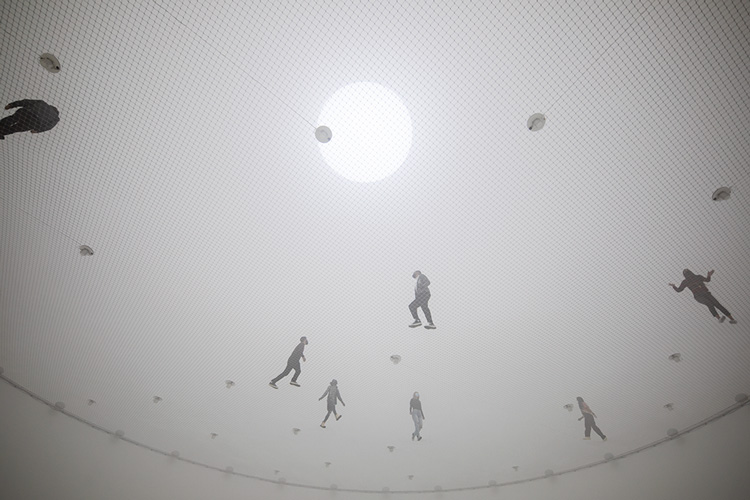
Tomás Saraceno, Free the Air: How to hear the universe in a spider/web, 2022. Custom steel, wire net, wood, light, LFE, shakers, fog. Diameter: 95 feet. Artwork © Studio Tomás Saraceno. Commissioned by The Shed. Photo: Nicholas Knight. Courtesy the artist and Tanya Bonakdar Gallery, New York/Los Angeles; Neugerriemschneider, Berlin; Andersen’s, Copenhagen; Ruth Benzacar, Buenos Aires; and Pinksummer Contemporary Art, Genoa. Photo courtesy The Shed.
The practical applications of that skill are intriguing as well as game-changing, from innovative and better building materials to illuminating the structure of the cosmos. Spread across two floors (level 2 and 4) and the Shed’s vast McCourt space, it is a marvel of an art and science project (who says that science isn’t also art?) and a crowd pleaser, even if spiders creep you out (although no actual spiders are included in these presentations. In fact, many of us who have read EB White’s Charlotte’s Web, an American children’s classic, are rather predisposed in their favour, seeing them as creative, literate, industrious and noble creatures. Their webs, incidentally, are antiseptic and can be used for cleaning wounds.)
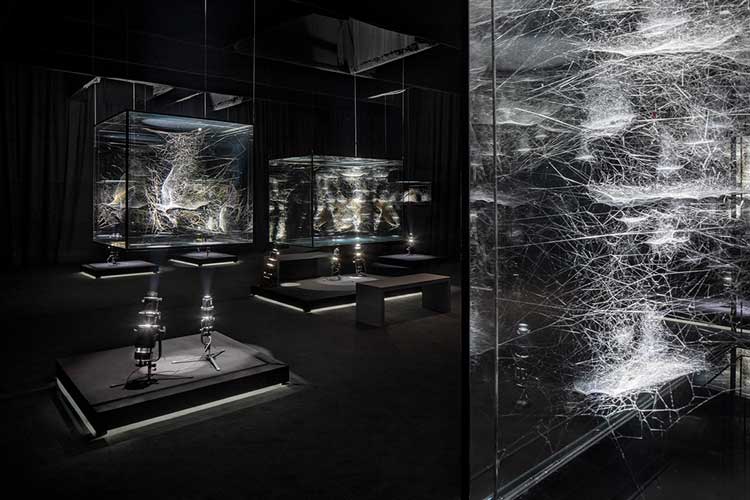
Tomás Saraceno, Webs of At-tent(s)ion (detail), 2020. Seven spider frames, spider silk, carbon fibers, lights. Dimensions variable. Artwork © Studio Tomás Saraceno. Photo: Nicholas Knight. Courtesy the artist; spider/webs; Tanya Bonakdar Gallery, New York/Los Angeles; and Neugerriemschneider, Berlin. Photo courtesy The Shed.
In darkened galleries, the exhibition’s opening gambit presents, among other displays, lighted crystalline webs of dazzling beauty housed in glass vitrines. Constructed on frames in the artist’s studio by different species of spiders, which he monitored, it was a collaboration between the two. Other galleries feature the movement of webs translated into sound and light, at times using laser scans that create a kind of red shift. The labels are well-written and essential to parsing the exhibition, but labels, especially lengthy ones, are always a bit of a turnoff in a visual exhibition, diverting our gaze from the display. An on-demand audio explication would have been better, so the viewer could look at the work while simultaneously listening, something that neither the labels nor the comprehensive catalogue that accompanies the show allow for.
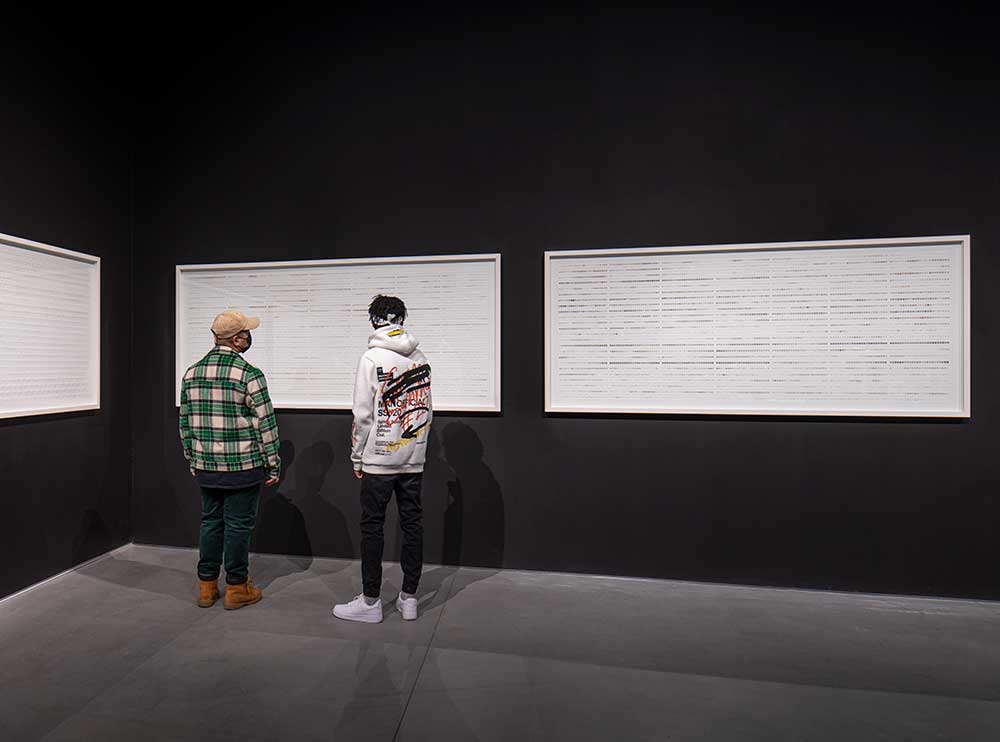
Tomás Saraceno, We Do Not All Breathe the Same Air (detail), 2019 – 22. Black carbon, soot, PM2.5, PM10, paper. Each frame: approx. 91 x 39.5 inches; each paper strip: approx. 85.8 inches. Artwork © Studio Tomás Saraceno. Commissioned by The Shed. Photo: Nicholas Knight. Courtesy the artist; Tanya Bonakdar Gallery, New York/Los Angeles; and Neugerriemschneider, Berlin. Photo courtesy The Shed.
Air pollution is another subject that engrosses Saraceno, and includes the Shed commission, We Do Not All Breathe the Same Air. It measured, over two years, on seven large sheets of paper, one for each state it documented, the degree of pollution across the selected region, demonstrating how that occurs along racial and other socially inequitable divides. The show’s title here is a pun on particulate matter, the tiny specks of waste in the air that we breathe in and are hazardous to the health of life forms in general, not just humans.

Museo Aero Solar, 2007 – . Reused plastic bags, tape, ventilator, polyester rope. Approx. 39.4 x 52.5 x 19 feet. Photo: Nicholas Knight.
There is also a related installation called Museo Aero Solar, in another space in The Shed. A merry patchwork of colourful recycled plastic grocery bags, it is a grounded, gigantic balloon that can be walked into and part of his Aeroscene Foundation, a global not-for-profit organisation committed to the development of flying without fuel, propelled only by wind and light, ushering in the clean-air era of the Aerocene to save us all from extinction.
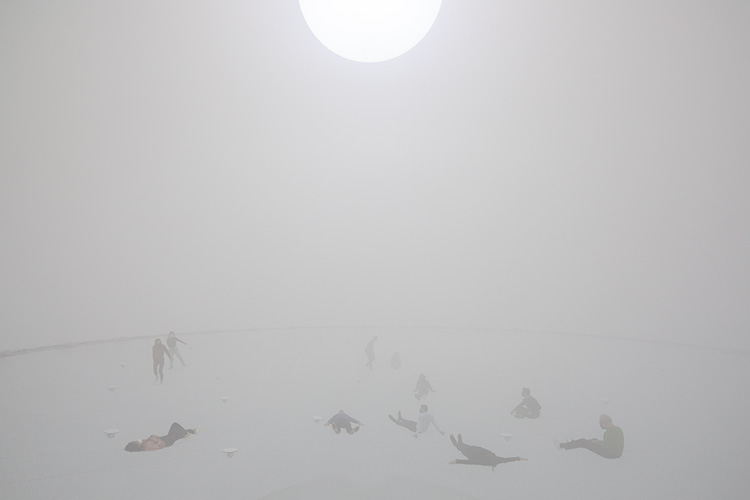
Tomás Saraceno, Free the Air: How to hear the universe in a spider/web, 2022. Custom steel, wire net, wood, light, LFE, shakers, fog. Diameter: 95 feet. Artwork © Studio Tomás Saraceno. Commissioned by The Shed. Photo: Nicholas Knight. Courtesy the artist and Tanya Bonakdar Gallery, New York/Los Angeles; Neugerriemschneider, Berlin; Andersen’s, Copenhagen; Ruth Benzacar, Buenos Aires; and Pinksummer Contemporary Art, Genoa. Photo courtesy The Shed.
The showstopper, however, also a commission, is Free the Air: How to Hear the Universe in a Spider/Web, the latter part of the title perhaps a nod to William Blake, taking up the entirety of the colossal shape-shifting McCourt. On two levels, one at six metres (20 feet) up (which has a wheelchair accessible viewing platform) and the other at 12 metres, a tight but still open-weave stainless-steel-mesh net is stretched across the space, 29 metres in diameter, above which is an enormous white spherical dome. You can choose which level you want to enter, but if you opt for the upper, which requires climbing eight flights of stairs, you must check anything loose on you into lockers before, so you won’t inadvertently drop something on viewers below. Also, no high heels.
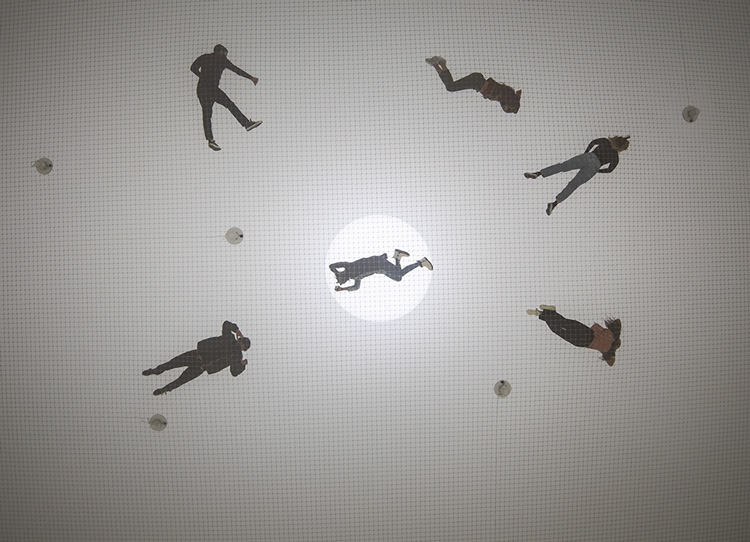
Tomás Saraceno, Free the Air: How to hear the universe in a spider/web, 2022. Custom steel, wire net, wood, light, LFE, shakers, fog. Diameter: 95 feet. Artwork © Studio Tomás Saraceno. Commissioned by The Shed. Photo: Nicholas Knight. Courtesy the artist and Tanya Bonakdar Gallery, New York/Los Angeles; Neugerriemschneider, Berlin; Andersen’s, Copenhagen; Ruth Benzacar, Buenos Aires; and Pinksummer Contemporary Art, Genoa. Photo courtesy The Shed.
Once you enter, the doors are locked for the 20-minute cycle. It takes a moment, maybe more, to acclimate to the trampoline-like bounce in the net. It is also disorienting to be able to see below in a straight plummet to the ground. Some of us walked upright and some skittered across on our rears. Soon, the light dims and goes out, the total blackness sharpening our sense of sound, the volume rising, picking up movements in the air, a snap, crackle and pop here and there, but lulling. Vibrations in the net also seem to increase although the effect is more soothing than otherwise. It is haunting, and too short, an experimental music concert that simulates a spider’s perceptions while on the ropes, a mesmerising, provocative, multisensory extravaganza that is playful – with a deadly serious message.
Speaking of accessibility, which The Shed often does and its desire to reach out to less privileged communities, that accessibility is also a monetary matter. At $35 a person to visit Particular Matter(s), is there a solution to that? After all, the spiders spun their nets for free.
For other recent works by Saraceno (without charge), there is Silent Autumn, a less daunting but equally ravishing, equally absorbing exhibition about the complex relationships between humans and non-humans, and the worlds in which we all must live, at Tanya Bonakdar, his gallery in Chelsea, on view until 26 March.
New paintings by American artist, Pat Steir, now 87, make their debut in this exhibition in Zurich...
Lubaina Himid with Magda Stawarska: Another Chance Encounter
Drawing on correspondence between the writer Sophie Brzeska and the artist Nina Hamnett as well as H...
Collaborating with craftspeople from around the world, Seulgi Lee incorporates traditional technique...
Mika Rottenberg – interview: ‘I’m not an angel or a political activi...
The multidisciplinary artist Mika Rottenberg talks about her first solo exhibition in Spain, at Haus...
Berlin. Cosmopolitan: The Vanished World of Felicie and Carl Bernstein
This small but insightful show puts the spotlight on a microcosm within Berlin’s art world at the ...
Emma Talbot – interview: ‘I imagine the experience of life as an epic...
Large installations, paintings on silk, fabric sculptures and drawings convey the connection between...
To mark its 40th birthday, Ditchling Museum of Art + Craft is hosting an exhibition all about reachi...
Mike Nelson: Humpty Dumpty, a transient history of Mardin earthworks low r...
From the architecture of an old hilltop city in Turkey to the demolished Heygate Estate in south Lon...
Jenny Saville: The Anatomy of Painting
Jenny Saville: This astounding show brings together the very best of an incomparable artist: absorbi...
From a mother bathing her children to cleaners working at the gallery, Margaret Salmon gives voice t...
Slavs and Tatars: The Contest of the Fruits
Rapping fruit, legendary birds and nail art feature in the UK debut of the Berlin-based collective S...
Liverpool Biennial 2025: Bedrock
From Sheila Hicks’s gemstone-like sculptures to Elizabeth Price’s video essay on modernist Catho...
Mikhail Karikis – interview: ‘What is the soundscape of the forthcomin...
Mikhail Karikis explains the ideas behind his new sound and video installation calling for action ag...
Art & the Book* and Spineless Wonders: The Power of Print Unbound**
Two concurrent exhibitions bring special collections into broader spaces of circulation, highlightin...
Focusing on the skills of wallpaper design and embroidery, this exhibition tells the story of the ...
Daphne Wright: Deep-Rooted Things
This show is a celebration of the domestic, and the poignant sculpture of Wright’s two sons, now o...
Anna Boghiguian: The Sunken Boat: A Glimpse into Past Histories
The venerable Egyptian Canadian installation artist Anna Boghiguian brings shipwrecks, shells and th...
Abstract Erotic: Louise Bourgeois, Eva Hesse, Alice Adams
A groundbreaking New York show from 1966 is brought back to life with the work of three women whose ...
Jeremy Deller – interview: ‘I’m not looking for the next thing. I...
How did he go from asking a brass band to play acid house to filming former miners re-enacting a sem...
Encounters: Giacometti x Huma Bhabha
The first of three exhibitions to position historic sculptures by Alberto Giacometti with new works ...
The Parisian scenes that Edward Burra is known for are joyful and sardonic, but his work depicting t...
The 36th Ljubljana Biennale of Graphic Arts: The Oracle
Surprising, thrilling, enchanting – under the artistic direction of Chus Martínez, the works in t...
It’s Terrible the Things I Have to Do to Be Me: On Femininity and Fame ...
In a series of essays about pairs of famous women, the cultural critic Philippa Snow explores the co...
Paul Thek: Seized by Joy. Paintings 1965-1988
A rare London show of elusive queer pioneer Paul Thek captures a quieter side of his unpredictable p...
This elegantly composed exhibition celebrates 25 years’ of awards to female artists by Anonymous W...
The first of its kind, this vast show is a stunning tour of the realism movement of the 1920s and 30...
Maggi Hambling: ‘The sea is sort of inside me now … [and] it’s as if...
Maggi Hambling’s new and highly personal installation, Time, in memory of her longtime partner, To...
Caspar Heinemann takes us on a deep, dark emotional dive with his nihilistic installation that refer...
Complex, multilayered paintings and sculptures reek of the dark histories of slavery and colonialism...
Shown in the context of the historic paintings of Dulwich Picture Gallery, Rachel Jones’s new pain...